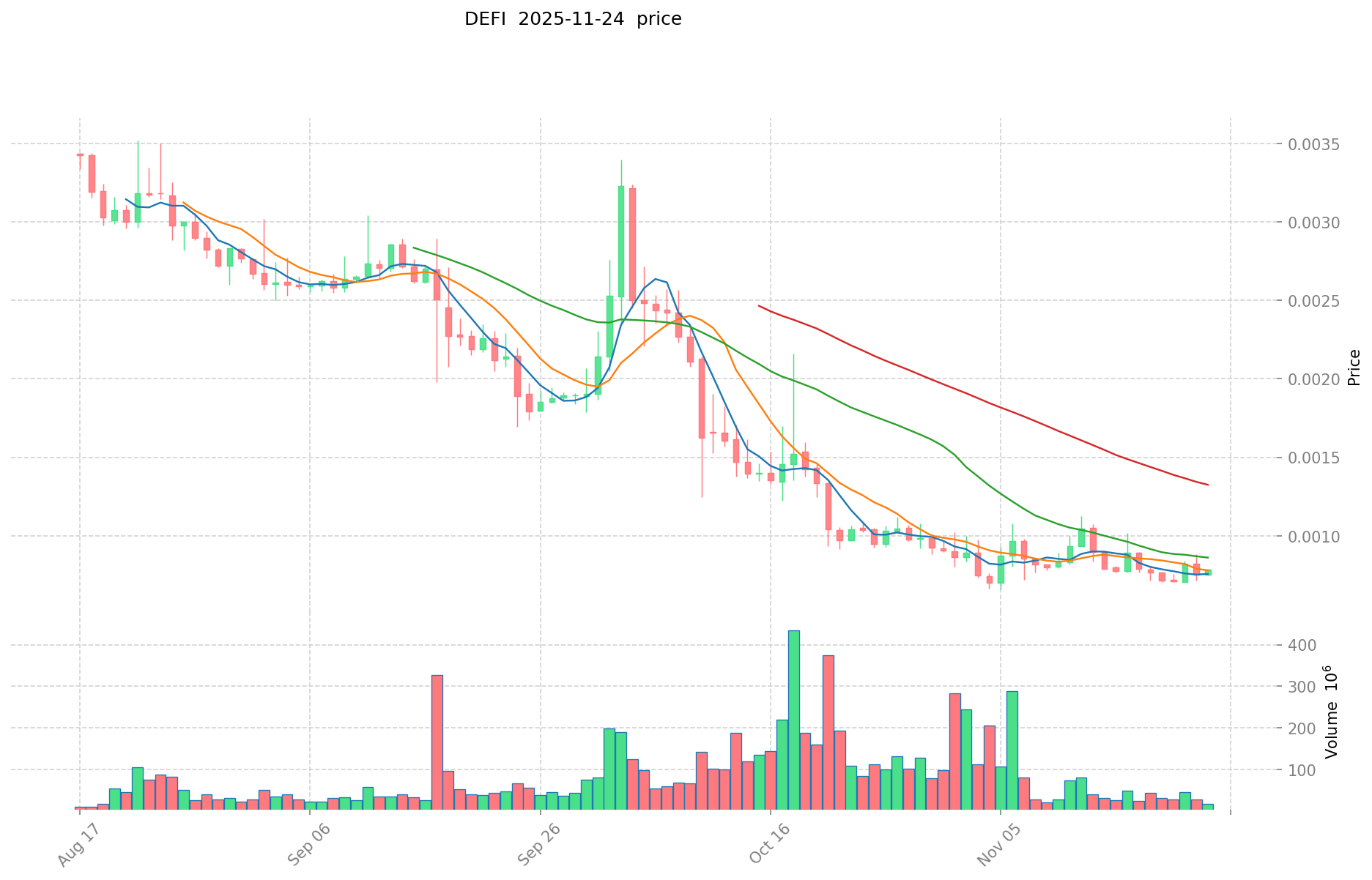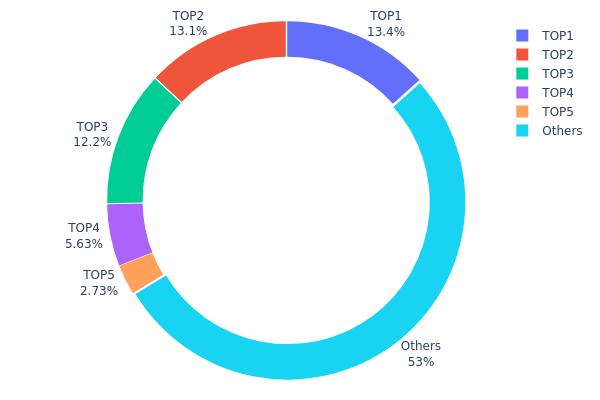2025 DEFI Price Prediction: Bullish Trends and Key Factors Shaping the Future of Decentralized Finance
Introduction: DEFI's Market Position and Investment Value
De.Fi (DEFI), positioned as a Web3 SocialFi and Antivirus solution, has been making strides in the cryptocurrency market since its inception. As of 2025, De.Fi's market capitalization stands at $1,610,531, with a circulating supply of approximately 1,878,389,653 tokens, and a price hovering around $0.0008574. This asset, often referred to as the "Web3 SocialFi & Antivirus," is playing an increasingly crucial role in risk mitigation and investor onboarding in the decentralized finance sector.
This article will provide a comprehensive analysis of De.Fi's price trends from 2025 to 2030, considering historical patterns, market supply and demand, ecosystem development, and macroeconomic factors to offer professional price predictions and practical investment strategies for investors.
I. DEFI Price History Review and Current Market Status
DEFI Historical Price Evolution
- 2024: Initial coin offering at $0.2, price peaked at $1.09 on January 31
- 2025: Market downturn, price dropped to an all-time low of $0.0006559 on November 5
DEFI Current Market Situation
As of November 25, 2025, DEFI is trading at $0.0008574, with a 24-hour trading volume of $13,159.69. The token has seen a significant 12.88% increase in the last 24 hours. However, DEFI is currently down 99.92% from its all-time high of $1.09 set on January 31, 2024. The current market cap stands at $1,610,531, ranking DEFI at #2304 in the cryptocurrency market. The circulating supply is 1,878,389,653 DEFI tokens, which represents 62.61% of the maximum supply of 3,000,000,000 DEFI. Despite the recent 24-hour gain, DEFI has experienced a 10.94% decrease over the past 30 days and a substantial 95.07% decline over the last year, indicating a prolonged bearish trend.
Click to view the current DEFI market price

DEFI Market Sentiment Indicator
2025-11-24 Fear and Greed Index: 19 (Extreme Fear)
Click to view the current Fear & Greed Index
The DEFI market is currently experiencing a state of extreme fear, with the sentiment index plummeting to 19. This low reading suggests investors are exceptionally cautious and risk-averse. Such extreme fear often precedes potential buying opportunities, as assets may be undervalued. However, traders should remain vigilant and conduct thorough research before making any decisions. Remember, market sentiment can shift rapidly, and it's crucial to stay informed about broader market trends and developments in the DEFI space.

DEFI Holdings Distribution
The address holdings distribution data provides crucial insights into the concentration of DEFI tokens. The top three addresses hold a significant portion of the total supply, with 13.35%, 13.06%, and 12.22% respectively, collectively accounting for 38.63% of all tokens. This concentration level raises concerns about potential market manipulation and volatility.
While the top five addresses control 46.99% of the supply, it's noteworthy that 53.01% is distributed among other addresses. This distribution pattern suggests a moderate level of decentralization, but with a notable skew towards larger holders. The presence of these major stakeholders could impact market dynamics, potentially leading to increased price fluctuations if large transactions occur.
Overall, this distribution reflects a market structure with a mix of significant players and broader participation. It indicates a developing ecosystem that's still maturing in terms of decentralization. Monitoring these top addresses' activities could provide valuable insights into potential market movements and the overall health of the DEFI token's ecosystem.
Click to view the current DEFI Holdings Distribution

| Top | Address | Holding Qty | Holding (%) |
|---|---|---|---|
| 1 | 0x0529...c553b7 | 144416.56K | 13.35% |
| 2 | 0x0d07...b492fe | 141306.68K | 13.06% |
| 3 | 0xf89d...5eaa40 | 132275.75K | 12.22% |
| 4 | 0x655f...461d51 | 60906.87K | 5.63% |
| 5 | 0x8c7e...88973e | 29531.51K | 2.73% |
| - | Others | 573162.63K | 53.01% |
II. Key Factors Influencing Future DEFI Prices
Supply Mechanism
- Historical Patterns: Past supply changes have significantly impacted DeFi token prices, with reduced supply often leading to price increases.
- Current Impact: The ongoing reduction in new token issuance is expected to create upward pressure on prices due to increased scarcity.
Institutional and Whale Dynamics
- Institutional Holdings: Major financial institutions are increasingly adopting DeFi protocols, contributing to growing TVL and token demand.
- Corporate Adoption: Notable companies are integrating DeFi solutions, enhancing legitimacy and potential use cases.
Macroeconomic Environment
- Monetary Policy Impact: Expected interest rate cuts may drive more capital into DeFi markets, similar to the 2020-2021 DeFi Summer.
- Inflation Hedging Properties: DeFi tokens are increasingly viewed as potential hedges against inflation, particularly in uncertain economic times.
Technological Developments and Ecosystem Building
- Layer 2 Integration: Ongoing improvements in Layer 2 solutions are reducing transaction costs and increasing scalability for DeFi protocols.
- Cross-Chain Interoperability: Advancements in cross-chain technologies are expanding DeFi's reach and utility across multiple blockchain ecosystems.
- Ecosystem Applications: The proliferation of innovative DApps and yield farming opportunities continues to drive user engagement and token demand.
III. DEFI Price Prediction for 2025-2030
2025 Outlook
- Conservative forecast: $0.00081 - $0.00087
- Neutral forecast: $0.00087 - $0.00099
- Optimistic forecast: $0.00099 - $0.00111 (requires positive market sentiment and increased DeFi adoption)
2027-2028 Outlook
- Market phase expectation: Potential growth phase with increased volatility
- Price range prediction:
- 2027: $0.00067 - $0.00158
- 2028: $0.00100 - $0.00186
- Key catalysts: DeFi ecosystem expansion, technological advancements, and regulatory clarity
2030 Long-term Outlook
- Base scenario: $0.00088 - $0.00173 (assuming steady market growth and adoption)
- Optimistic scenario: $0.00173 - $0.00202 (assuming widespread DeFi integration and favorable regulations)
- Transformative scenario: $0.00202+ (extreme favorable conditions such as mainstream financial sector adoption)
- 2030-12-31: DEFI $0.00202 (potential peak based on optimistic projections)
| 年份 | 预测最高价 | 预测平均价格 | 预测最低价 | 涨跌幅 |
|---|---|---|---|---|
| 2025 | 0.00111 | 0.00087 | 0.00081 | 1 |
| 2026 | 0.00139 | 0.00099 | 0.00079 | 15 |
| 2027 | 0.00158 | 0.00119 | 0.00067 | 38 |
| 2028 | 0.00186 | 0.00139 | 0.001 | 61 |
| 2029 | 0.00183 | 0.00162 | 0.00099 | 89 |
| 2030 | 0.00202 | 0.00173 | 0.00088 | 101 |
IV. DEFI Professional Investment Strategies and Risk Management
DEFI Investment Methodology
(1) Long-term Holding Strategy
- Suitable for: Risk-tolerant investors with a long-term perspective
- Operational suggestions:
- Dollar-cost averaging to mitigate short-term volatility
- Regular portfolio rebalancing to maintain desired asset allocation
- Secure storage using hardware wallets or reputable custodial services
(2) Active Trading Strategy
- Technical analysis tools:
- Moving Averages: Identify trends and potential reversals
- Relative Strength Index (RSI): Gauge overbought or oversold conditions
- Key points for swing trading:
- Set clear entry and exit points based on technical indicators
- Use stop-loss orders to limit potential losses
DEFI Risk Management Framework
(1) Asset Allocation Principles
- Conservative investors: 1-3%
- Aggressive investors: 5-10%
- Professional investors: 15-20%
(2) Risk Hedging Solutions
- Diversification: Spread investments across multiple cryptocurrencies and traditional assets
- Options strategies: Use put options to protect against downside risk
(3) Secure Storage Solutions
- Hardware wallet recommendation: Gate Web3 Wallet
- Cold storage solution: Paper wallets for long-term, offline storage
- Security precautions: Enable two-factor authentication, use strong passwords, and regularly update software
V. DEFI Potential Risks and Challenges
DEFI Market Risks
- High volatility: Extreme price fluctuations can lead to significant losses
- Liquidity risk: Potential difficulty in selling assets during market downturns
- Market manipulation: Susceptibility to pump-and-dump schemes or large whale movements
DEFI Regulatory Risks
- Uncertain regulatory environment: Potential for sudden changes in government policies
- Cross-border compliance issues: Varying regulations across different jurisdictions
- Taxation complexities: Evolving tax laws related to cryptocurrency transactions
DEFI Technical Risks
- Smart contract vulnerabilities: Potential for exploits or bugs in the underlying code
- Scalability challenges: Network congestion leading to high transaction fees or delays
- Interoperability issues: Compatibility problems between different blockchain networks
VI. Conclusion and Action Recommendations
DEFI Investment Value Assessment
DEFI presents a high-risk, high-reward investment opportunity with potential for significant growth in the Web3 and SocialFi spaces. However, investors should be prepared for extreme volatility and regulatory uncertainties in the short to medium term.
DEFI Investment Recommendations
✅ Beginners: Start with small investments, focus on education and understanding the technology
✅ Experienced investors: Implement a balanced portfolio with DEFI as a high-risk component, use dollar-cost averaging
✅ Institutional investors: Conduct thorough due diligence, consider OTC trading for large positions, and implement robust risk management strategies
DEFI Participation Methods
- Centralized exchanges: Trade DEFI tokens on Gate.com for ease of use and liquidity
- Decentralized exchanges: Participate in DeFi protocols for yield farming or liquidity provision
- Staking: Earn passive income by participating in network security or governance
Cryptocurrency investments carry extreme risks, and this article does not constitute investment advice. Investors should make decisions based on their own risk tolerance and are advised to consult professional financial advisors. Never invest more than you can afford to lose.
FAQ
Is DeFi a good stock to buy?
DeFi is not a stock, but a sector in crypto. It offers high potential returns but with significant risks. Careful research is crucial before investing.
Is DeFi coin a good investment?
DeFi coins offer high potential returns in the evolving crypto market. With growing adoption and innovation in decentralized finance, DeFi coins could be a lucrative investment for risk-tolerant investors in 2025.
What crypto will 1000x prediction?
DeepSnitch AI is predicted to 1000x by 2026. It's developing AI tools for crypto trading. Other potential 1000x candidates include Pi Network and PUMP.
What is the future of DeFi coin?
DeFi coin's future looks bright with potential for significant growth. As adoption increases and technology advances, its value is likely to rise substantially, making it a promising long-term investment in the evolving decentralized finance landscape.
Share
Content